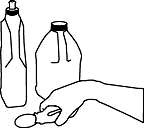renewal cycles. Complete
some now & some later.
and Get 25% off
the Total price!
Buy 3 Courses
and Get 30% off
the Total price!
Buy 4 Courses
and Get 35% off
the Total price!
| Create Account | Login | |

Section 23
Adaptive Handle
Table of Contents | NCCAP/NCTRC CE Booklet
 Some residents have a hard time holding a spoon for an activity like Bean Scooping described in Volume Two of this Series. When the resident's thumb and index finger get about one inch apart, many lose their ability to grasp. The Adaptive Handle is a way to make the handle of a spoon wider to facilitate one of your activities like Bean Scooping, where the resident needs to grasp something that is narrow, like a crayon, paintbrush, etc.
Some residents have a hard time holding a spoon for an activity like Bean Scooping described in Volume Two of this Series. When the resident's thumb and index finger get about one inch apart, many lose their ability to grasp. The Adaptive Handle is a way to make the handle of a spoon wider to facilitate one of your activities like Bean Scooping, where the resident needs to grasp something that is narrow, like a crayon, paintbrush, etc.
Here’s how you can make an Adaptive Handle. Cut a handle from a fabric softener bottle or a bleach bottle. Slide a table spoon into the handle. It works best if you can buy a generic brand softener, because the handle on the bottle tends to be narrower, which facilitates the holding of the spoon handle inside the tubular part of the bottle handle, as illustrated. The last track of the DVD that accompanies this course contains photos that show two different types of Adaptive Handles. Of course, you can always check out the Internet for inexpensive adaptive handles that look like foam cylinders with a hole in the middle. A good way to assess if a resident needs an Adaptive Handle is to place a pencil or a spoon in his or her hand and observe what happens with his or her thumb and index finger’s ability to grasp.
Residents with whom to try an Adaptive Handle
| Resident | Who will gather materials and/or construct project? |
Staff /Volunteer to work with resident? When? |
|
|
|
|
|
|
Progress Note: See page 7 for details regarding this four-part implementation procedure, which can become the basis of a Progress Note, stating “When I tried an Adaptive Handle with _________________, the following occurred… |
1. Observation: |
2. Assessment: |
3. Creativity: |
4. Sensitivity: |
Culture Change Implementation: Place an Adaptive Handle in labeled Activity Project Bag left in resident’s room for CNA, etc. use.
NCCAP/NCTRC CE Booklet
Forward to Section 24
Back to Section 22
Table of Contents
Top


